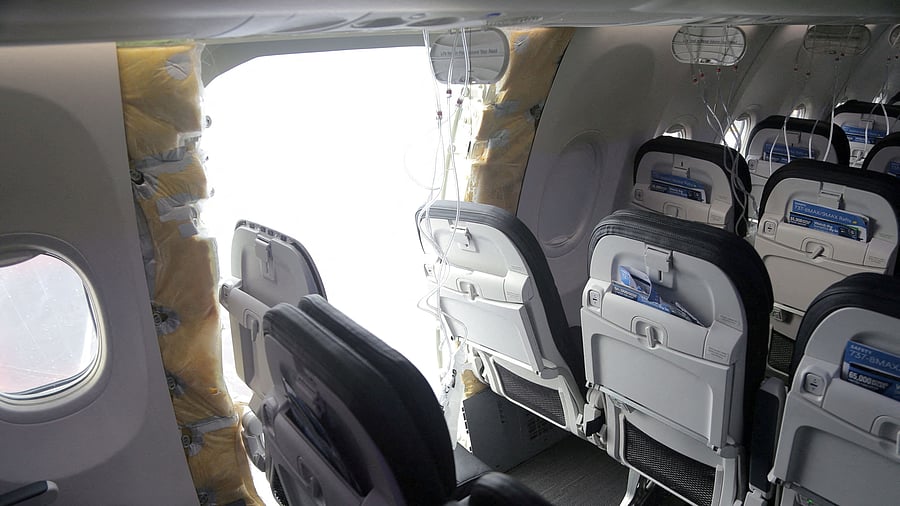
The fuselage plug area of Alaska Airlines Flight 1282 Boeing 737-9 MAX, which was forced to make an emergency landing with a gap in the fuselage, is seen during its investigation by the National Transportation Safety Board in Portland.
Credit; Reuters Photo
Washington: Boeing will add more quality inspections for the 737 MAX after a mid-air blowout of a cabin panel in an Alaska Airlines MAX 9 earlier this month and has appointed an independent advisor to tackle quality management issues.
The fuselage tore off the left side of an Boeing 737 MAX 9 jet shortly after taking off from Portland, Oregon, on Jan. 5. The incident left a gaping hole in the side of the plane while in mid-air, and forced a dramatic emergency landing.
The panel is a plug in place on some 737 MAX 9s instead of an additional emergency exit. Regulators have grounded 171 planes so airlines can inspect those crafts. At least two air carriers have found that bolts used to secure that panel were loosened. Here is an explainer on that panel.
WHAT HAPPENED?
As Alaska Air Flight 1282 reached just over 16,000 feet on Jan. 5, the panel tore off from the side of the jet, leaving a refrigerator-sized, rectangular hole in the aircraft. The door plug was later discovered by a Portland school teacher who found it in his backyard.
WHY IS THIS PANEL THERE?
The 737 MAX 9, currently Boeing's largest single-aisle plane in production, can seat up to 220 people. It includes an optional extra door to allow for the approved number of evacuation paths whenever carriers opt to install more than 189 seats.
Planes that do not opt for additional seating can replace that door with a panel, or plug. Door plugs have been used to adapt aircraft and offer flexible layouts across the industry for years.
Certain models of Airbus jetliners also feature door plugs, but the European planemaker uses a different design, people close to the company said.
HOW IS THE DOOR PLUG HELD IN PLACE?
A diagram of the 737 MAX 9 door plug posted by the U.S. National Transportation Safety Board shows the plug held down by four bolts: two in the upper corners and two lower hinge brackets. The diagram also shows two straps and two bonding jumpers near the bolts.
The plug is further secured by "stop fittings" at 12 different locations along the side of the plug and the door frame. The fittings hold the plug in place, preventing it from being pushed out of the airframe, according to NTSB head Jennifer Homendy.
The plug measures 26 by 48 inches (66 by 122 cm) and weighs 63 pounds (29 kg), Homendy said.
All 12 of the stop fittings became disengaged during the event, and the guide tracks on the plug were fractured as well, NTSB engineer Clint Crookshanks told reporters at a briefing in Portland.
The NTSB said it could not yet determine whether the door plug had been properly attached, but will be able to establish whether the bolts were present after examining markings on the door plug.
WHO MAKES THIS PANEL?
The fuselage for the Boeing 737 is made by Kansas-based Spirit AeroSystems, which separated from Boeing in 2005. Spirit is one of two suppliers that makes the plug doors on the MAX 9, but Boeing also has a key role in the plug installation process.
Spirit builds fuselages for 737s and sends them to Boeing's Renton, Washington, plant. There, the hull is pressurized to 150% to make sure everything is working correctly.
Boeing is sending a team to Spirit to check and approve Spirit's work on the plugs before fuselages are sent to Boeing's production facilities, Stan Deal, president of Boeing Commercial Airplanes, said in a letter to Boeing employees on Jan. 15.
HOW MANY OF THESE PLANES ARE THERE AND HOW MANY ARE GROUNDED?
Of the 200-plus 737 MAX 9 planes Boeing has delivered, 189 have this panel in place of a door, according to FlightRadar24.
The FAA grounding order relates specifically to 171 planes that are operated by U.S. airlines or fly to U.S. territory. United Airlines has grounded 79 planes, and Alaska has grounded 65. Other carriers that have grounded planes include Panama's Copa Airlines, Aeromexico and Turkish Airlines.